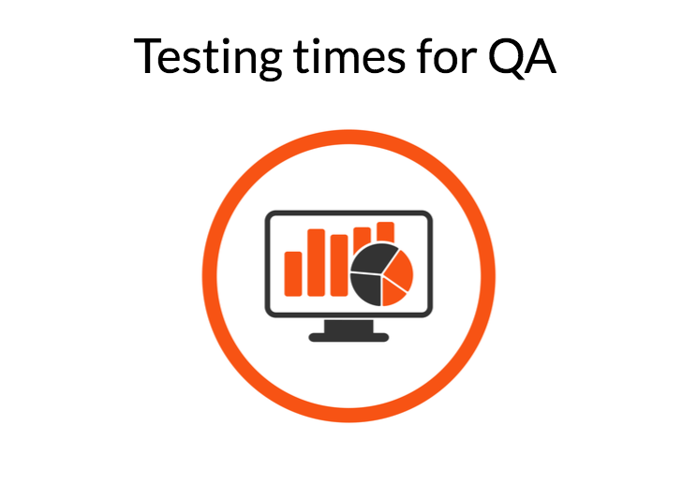How to Use QA for Company Growth
The QA role
A common misconception about QA is that it’s just testing. Although testing is a vital part of the process, it’s important to recognise that QA is much more than that. QA undoubtedly plays a crucial role in the success of your app or website. It helps to reduce costs by removing waste, improves efficiency and enhances the customer experience. This earns the organisation a reputation for excellence and grows their customer base.
Yet many CTOs are unsure of what they should be doing with their QA.
Before we talk about how you can leverage your QA for growth, let’s take a look at some statistics from the World Quality Report 2017-18 to understand some of the obstacles QA professionals and departments are facing.
Not having enough time
Just over half (52%) of the respondents said that they don't have enough time to test. This figure is understandable as the speed of release is becoming ever more critical. The challenge is that customers demand new features and updates regularly without a loss in quality.
Lack of a testing environment
Surprisingly, 41% of the respondents said that they don’t have in-house testing environments when testing mobile and multi-channel applications. This points to the fact that test environment stability and test data remain key challenges for QA. It begs the question: how are firms testing their mobile apps, then?
Device coverage
Device coverage remains a problem, with 40% of the respondents stating that they don’t have devices readily available to test on. This suggests that developers have difficulty testing the different combinations of devices, operating systems and OS configurations.
Add testing the back-end applications and cloud data (don’t forget the need to boost the performance, security and user experience) and you can appreciate the complexity that organisations are facing.
Lack of exploratory testing
Only 37% of the respondents use exploratory testing, which is a rise from 2017 (31%) but a fall from 2015 (40%). This suggests that although some organisations have adopted exploratory testing into their testing strategy, the barriers for some are still too great.
These hurdles include the difficulty of getting exploratory testing right, its unstructured nature leading to inefficiency and the frustration of struggling to find good testers with a certain mindset.
Transforming QA into a growth mindset
A growth mindset for QA is a pretty scary jump. A few years ago, the idea that QA could be used to grow your organisation would have been ridiculed. After all, isn’t the point of QA merely to test software and find the bugs? On the contrary, as we’ve discussed already, QA is much more than that.
QA provides a unique opportunity to deliver exceptional experiences for customers and thus help the organisation to grow.
Improving quality
Regardless of your application type or your industry, it’s clear that quality remains as important as ever, if not more so. It’s vital you use QA to improve the quality of your app or website.
Today’s end-user has zero tolerance for errors or slow performance. Poor quality can result in serious damage to your brand value and often incurs huge repair costs.
Decreasing cost of development
QAs must focus on cost optimisation and prioritise spending in higher-risk areas. The goal should always be to do more for less. Finding the right balance between cost and quality is the key.
If you have too many bugs at release, you didn’t test enough and released too early. If you have zero bugs, you tested too much and released too late. Just don’t be this guy!
Lasting effects of QA change
Changing the focus of your QA won’t yield one-off results. It will improve long-term efficiency in the whole development cycle and its teams. This concept led to us developing QAOps, a framework to help companies leverage QA for global growth.
Differentiation
QA is a trigger for competitive advantage in the rapidly changing world of software development. The World Quality Report 2017-18 shows that not all organisations are following QA best practices. Make sure your QA is leading the innovation in your field and not being left behind. Your approach to QA could be the difference between success and failure.
Managing developers and QA
Another important aspect is managing QA teams’ relationship with developers. QAs and developers have a somewhat love-hate relationship that includes...
...the good...
"Great work, you always find the little edge cases that really improve the product."
...the bad...
"That’s not a bug, it’s a nice-to-have. Anyway, it works as designed."
...and the ugly!
"Developer: What are you doing over the weekend?
QA: I’ve got to do over 1,500 tests.
Developer: Wow! Will you get them all done?
QA: Probably not.
Developer: So what happens if you don’t?
QA: Nothing. They will release it on Monday morning anyway."
It’s important to remember that poor quality will remain long after the joy of meeting a release deadline. Finding a bug isn’t criticising someone's work, it’s enhancing the product. It will organically improve quality and the customer experience.
Conclusion
Many CTOs are unsure of what they should be doing with their QA. If you fall into this category, you need to realign your QA and define an enterprise-wide QA strategy.
Global App Testing helps enterprise companies create high-growth QA strategies based on the QAOps framework.
Reserve your copy of QAOps: How the Right QA Can Increase Your Speed, Scale and Global Growth to learn more about what QAOps can do for you.


